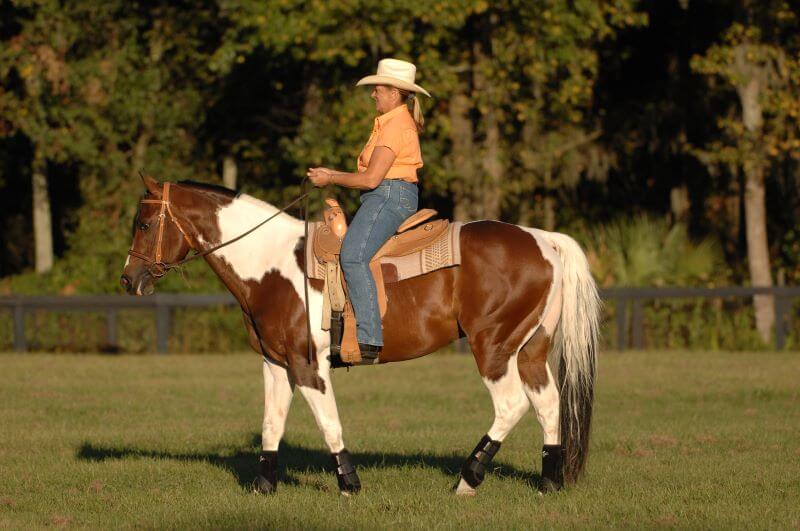Use Transitions to Develop Better Communication through Your Seat
by Lynn Palm
I’m going to discuss one of the rider’s most important yet often overlooked aids. Can you guess which one it is? If you said the rider’s seat, you’re right!
I’ll explain how the rider uses her seat by using the example of upward and downward transitions. As the rider puts weight in the saddle, the rotation and movement of her hips gives the horse the indication to go forward. When this rotation and movement decreases, it signals the horse to slow or stop.
Let me explain how this works using simple exercises you can use at home to improve communication with your horse.

Walk/Trot Transitions
The goal of this exercise is to use your seat rather than hand or leg aids to signal requests for upward and downward transitions from walk to trot (or jog).
Start by asking your horse to walk forward on a large circle. Gently follow his movement with your hips as he walks forward. Prepare for an upward transition to the jog/trot using your seat as the main tool for communicating to the horse. Do this by first putting more weight in your seat. As you do, rotate your hips to follow the horse’s movement and encourage him to increase his speed through the action of your seat.
Support this action by lightly applying leg aids (if needed) and slightly releasing the reins to encourage his forward movement. If needed, reinforce your requests with a “cluck”. He should pick up the jog/trot. Continue following his motion with your seat.
Jog/trot a segment of the large circle. Then turn him to make a smaller circle within the large one. We will use the smaller circle to ask him for a downward transition back to the walk.
Jog/trot a portion of the small circle and prepare for a downward transition using the seat. Once again put weight in your seat, but this time decrease the movement and rotation of your hips with the horse’s movement. He should make a transition from jog/trot to the walk in response to your seat aid. Praise him.
Do this exercise in both directions. As you practice this exercise, your seat aid will become more effective and your horse more responsive. You’ll notice that less leg and voice aids are necessary to achieve the transitions.
Trot/Canter Transitions
When the horse is comfortable and understands the aids communication for the walk/trot transition, it is time to try a jog to lope (trot to canter) transition. This exercise should be done in an arena or large fenced paddock or pasture. Be sure the horse is warmed up before starting this exercise. Repeat the walk/trot transition exercise (above) to reinforce the effectiveness of your seat, leg, and hand aids.
The exercise starts with trotting the horse on a large circle. The rider should post to the trot even if using a western saddle. Encourage the horse to depart into the canter by using the word command “canter”. (He should already know this voice command from ground training on the longe line, liberty, or round pen.) At the same time use seat and leg aids to encourage him to move forward into the canter. Keep a loose contact on the reins, lightly positioning him on the arc of the circle.
Continue following his motion with your seat while posting as he increases his speed and makes a transition to the lope/canter. At this point, it’s not important which lead he takes, just that he canters. When he begins loping/cantering, sit and follow the rocking motion of the gait with your seat and hips to encourage him to continue cantering.
Your Next Step
Most often when a horse has a problem picking up the correct lead, the rider is not maintaining the proper form and balance. When the horse has problems, the rider is not properly controlling his body position during trot to canter transitions. To achieve this requires an understanding of the rider’s turning aids.
Before I can go into more details about perfecting transitions, refer to my previous articles on turning aids and how they are used to position the horse. It will help you improve your transitions and may change your riding forever!
Until then, follow your dreams…
Published September 2019 Issue
Lynn Palm is the author of The Rider’s Guide to Real Collection and Your Complete Guide to Western Dressage. Her accomplishments include 2007 American Quarter Horse Association (AQHA) Horsewoman of the Year; AQHA Female Equestrian of the Year by the Women’s Athletic Association; named one of the top United States clinicians by Horse & Rider magazine; recipient of over 40 World and Reserve World Champions in AQHA and WDAA; USEF Western Dressage Horse of the Year and multiple USDF Champions; AQHA, ARHA and USEF Western Dressage R Judge. Lynn has given more than 50 bridleless exhibitions at events including the National Horse Show, 1989 World Cup, the 1996 Atlanta Olympic Games, 1996 World Cup, World Equestrian Games, and FEI World Cup.

